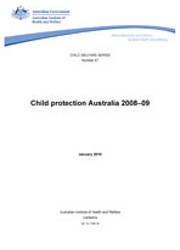Summary
Child Protection Australia 2008–09 is the thirteenth annual comprehensive child protection report. The report provides detailed statistical information on state and territory child protection and support services, and some of the characteristics of the children within these systems. In Australia, child protection is a state and territory government responsibility, and there are significant differences in how each deals with and reports child protection issues. Statistical comparisons between states and territories should therefore be treated with caution.
Main findings
Nationally the evidence in this report shows that:
- The number of children subject to a notification of child abuse or neglect; the number of children under care and protection orders; and the number in out-of-home care are all rising.
- Aboriginal and Torres Strait Islander children are over-represented in all of these areas.
It is important to note that although there appears to have been a real rise in children needing protection, other factors may have played a part. These include greater community awareness of child abuse and neglect issues, a broadening in what some jurisdictions define as child abuse or neglect, and changes in child protection policies and practices.
The reasons for the over-representation of Aboriginal and Torres Strait Islander children in the child protection system are complex and include the legacy of past policies of the forced removal of some Aboriginal children from their families, the intergenerational effects of previous separations from family and culture, and poor socioeconomic status.
Notifications, investigations and substantiations
- In the last 12 months:
- The number of children subject to a notification increased by 6.2% to 207,462.
- The number of children subject to a substantiation of a notification increased by 1.7% to 32,641 (from 6.8 to 6.9 per 1,000 children).
- Over the last 5 years the number of children subject to a substantiation of a notification has decreased by 4% (from 7.5 to 6.9 per 1,000 children).
Children on care and protection orders
- In the last 12 months the number of children on care and protection orders increased by 8.5% to 35,409 (from 6.6 to 7.0 per 1,000 children).
- Over the last 5 years the number of children on care and protection orders increased by 47% from 24,075 (from 4.8 to 7.0 per 1,000 children).
Children in out-of-home care
- In the last 12 months the number of children in out-of-home care increased by 9.3% to 34,069. Over the last 5 years the number of children in out-of-home care rose by 44% from 23,695 (from 4.9 to 6.7 per 1,000 children in 2009).
- Across Australia in 2008–09, 47% of children in out-of-home care were in foster care, 45% were in relative or kinship care and 5% were in residential care. This is consistent with the pattern of distribution observed over the last 5 years.
Aboriginal and Torres Strait Islander Children
In 2008–09:
- The rate of Indigenous children on care and protection orders was more than 8 times the rate of non-Indigenous children.
- The rate of Aboriginal and Torres Strait Islander children in out-of-home care was just over 9 times the rate of non-Indigenous children.
- Indigenous children were 7.5 times as likely to be the subject of substantiations as non-Indigenous children.
Intensive family support services
Family support services are services that seek to benefit families by improving their ability to care for children and to strengthen family relationships. Many jurisdictions have introduced family support services as an alternative early intervention response for less serious incidents where notifications do not involve child maltreatment.
- In 2008–09, 254 intensive family support services were delivered across 267 locations.
- Almost 50% of the children who received a support service were aged less than 5 years when they commenced the service.
- In most jurisdictions, the majority of children who commenced a support service were living with their parents.



